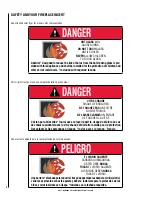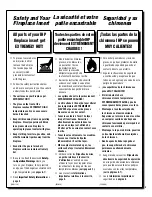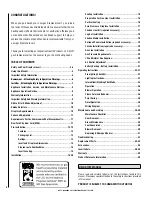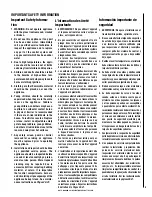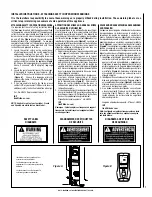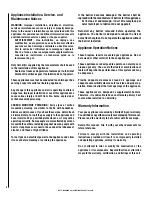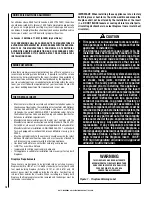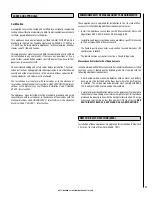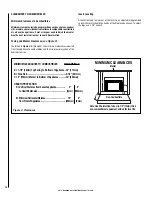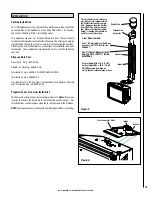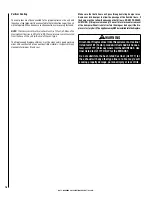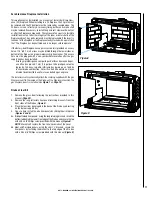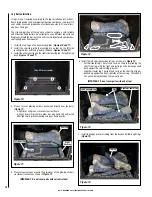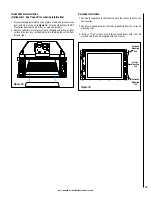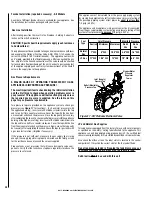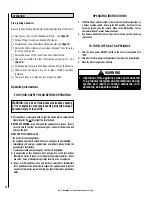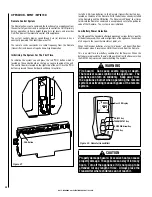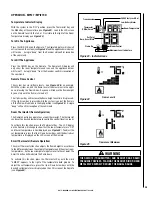
10
NOTE: DIAGRAMS & ILLUSTRATIONS ARE NOT TO SCALE.
For altitudes above 2,000 feet (In Canada 4,500 FT/1370 M), the orifice
should be de-rated by 4% for every 1,000 feet to maintain the proper ratio
of gas to air. Improper orifice sizing may result in damage and unsafe
conditions. Changing the orifice should only be done by a qualified service
technician. Contact your IHP dealer for proper orifice sizes.
In Canada - CAN/CGA-2.17-M91 (R2009) (high altitude):
THE CONVERSION SHALL BE CARRIED OUT BY A MANUFACTURER’S
AUTHORIZED REPRESENTATIVE, IN ACCORDANCE WITH THE REQUIRE-
MENTS OF THE MANUFACTURER, PROVINCIAL OR TERRITORIAL
AUTHORITIES HAVING JURISDICTION AND IN ACCORDANCE WITH
THE REQUIREMENTS OF THE CAN/CGA-B149.1 OR CAN/CGA-B149.2
INSTALLATION CODES.
ORIFICE SIZE/ALTITUDE ADJUSTMENT
THE FIREPLACE INSERT
Since there are always several potential sources of fire in any home, we
recommend installing smoke detectors. If possible, install the smoke
detector in a hallway adjacent to the room (to reduce the possibility of
occasional false activation from the heat produced by the appliance). If
your local code requires a smoke detector be installed within the same
room, you must follow the requirements of your local code. Check with
your local building department for requirements in your area.
SMOKE DETECTORS
WARNING
THIS FIREPLACE HAS BEEN ALTERED TO
ACCOMMODATE A FIREPLACE INSERT AND
SHOULD BE INSPECTED BY A QUALIFIED
PERSON PRIOR TO RE-USE AS A
CONVENTIONAL FIREPLACE.
• Must conform with all local, state and national installation codes. In
the absence of local codes, the installation must conform with National
Fuel Gas Code ANSI Z223.1 - latest edition, also known as NFPA 54
(In Canada, the current CAN/CGA B149.1 installation code). Refer to
the National Fuel Gas Code and local zoning and code authorities for
details on installation requirements.
•
Manufactured home installations (USA only) must conform with the
Manufactured Home Construction and Safety Standard, Title 24 CFR,
Part 3280, or, when such a standard is not applicable, the Standard for
Manufactured Home Installations, ANSI/NCSBCS A225.1, or Standard
for Gas Equipped Recreational Vehicles and Mobile Housing, CSA
Z240.4.
• Must be vented directly to the outside in accordance with the latest
edition of the National Fuel Gas Code and must never be attached to
a chimney serving a separate solid fuel burning appliance.
• Has been certified for use with either natural gas or propane.
• Is NOT for use with solid fuels.
• Is approved for sitting rooms and/or bedrooms.
• This appliance is suitable for installation into masonry or factory built
fireplaces.
Fireplace Requirements
These heaters are designed to be installed into an existing masonry
fireplace (built to UBC 37 or ULC S628 standards) or factory built solid
fuel, wood burning fireplace (listed to UL 127 or ULC S610) only. All
exhaust gases must be vented outside the structure. Combustion air
is drawn from outside the structure. When installing in a factory built
fireplace, the fireplace grate must be removed and the damper must be
removed or secured open.
IMPORTANT: When installing these appliances into a factory
built fireplace or heat-form, the air flow within and around the
fireplace shall not be altered by the installation of the insert
(i.e. DO NOT BLOCK louvers or cooling air inlet or outlet ports,
circulating air chambers in a steel fireplace liner or metal heat
circulator).
CAUTION
•
Trim panels or surrounds must not seal ventila-
tion openings in the existing fireplace that the
appliance is installed in.
•
The fireplace in which this gas insert is to be
installed must be thoroughly cleaned if it has
been used to burn wood or synthetic logs. Have
the chimney and all inside surfaces of the fire-
place brushed and vacuumed so that no soot,
embers, or loose combustion deposits can be
drawn into the heat circulation blower and blown
into the living area.
•
If any portion of the chimney system shows signs
of structural or mechanical weaknesses, such
as: cracks, leaky joints, corroded or warped
surfaces, the faulty portion must be repaired
or replaced prior to installing this appliance.
•
The factory built firebox must accept the insert
without modification other than removing bolted
or screwed together pieces such as baffles /
smoke shelf / deflectors, ash lips, glass door,
screen or door tracks, log grates, refractory or
masonry lining and damper assemblies. Any
fireplace component, which is removed, must be
retained so they can be reinstalled to restore the
fireplace to its original operating condition. The
removal of any part must not alter the integrity
of the outer shell of the pre-engineered fireplace
cabinet in any way. Any parts removed must be
replaceable. If any components are removed
from (or altered) from the existing fireplace, a
Warning Label (see below) must be affixed inside
the fireplace firebox, so that it shall be visible
upon removal of the fireplace insert. NOTE:
RTV high temperature silicone is an approved
adhesive to affix the label.
Figure 1 - Fireplace Warning Label


